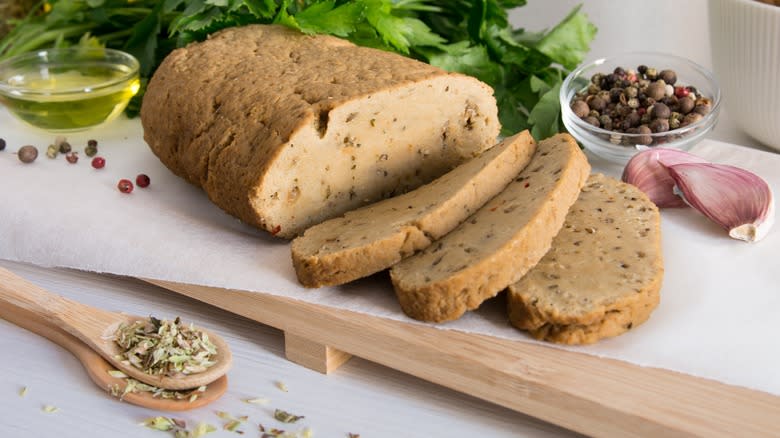If You Don't Like Tofu, Try Seitan As A Versatile Alternative

Going for a meatless diet no longer means having a significantly smaller source of proteins to choose from. If you feel that you've exhausted every possible culinary preparation you can do with tofu, you can try the similarly soy-based (but significantly different) tempeh. However, if you want to expand beyond soy, there is seitan, a plant-based meat alternative that's made from wheat gluten.
Specifically, seitan is prepared by adding water to wheat dough, kneading the mixture, and then washing away the starch, leaving behind only the dough's strengthened, high-protein gluten. This is then shaped into strips, loaves, or other shapes reminiscent of meat and then baked or steamed, which is how you'd find pre-packaged seitan in the supermarket. While gluten is certainly dangerous for people who are allergic or intolerant to it, it is a perfectly safe protein option for those who aren't. In fact, eating a 3-ounce serving of seitan can already provide you with 15 to 21 grams of protein. This amount may even increase depending on any other protein-rich ingredients that have been added to the product.
Of course, two of the biggest considerations when looking for a plant-based meat alternative are taste and texture. Seitan is just as versatile as tofu since it can take on the flavors of the seasonings and other ingredients it is cooked with. Where it edges out the latter is in its texture: As a form of pure protein, it has a chewy mouthfeel that is similar to that of meat.
Read more: 30 Healthy Snack Ideas That Won't Ruin Your Diet
Seitan's Texture Allows It To Be Cooked In Different Ways

Thanks to its meat-like texture, seitan can withstand cooking methods that the silkier and more crumbly tofu can't. Grill it in chunks on skewers or barbecue it in strips for a hearty sandwich filling. You can also use a food processor to turn seitan into a ground-beef substitute, adding it to stews, tacos, and pasta sauce. Stir-fry it or coat it with breading before plunging it into hot oil.
To understand better how versatile this meat alternative is, consider how integrated it is into Chinese and Buddhist cuisines, which have been using this ingredient for at least 2,000 years. If you have ever eaten a mock duck or chicken dish in a Chinese restaurant, the "poultry" was likely made of seitan. "Seitan" is actually the Japanese term for this meat alternative; its original Chinese name is mianjin, meaning "flour tendon" or "dough tendon."
Seitan must be cooked first before it is used in a recipe, whether it's store-bought or homemade. Poaching or pan-frying it will do the trick. Use this prepping method as a way to incorporate more flavor into seitan through flavoring agents like soy sauce, oyster sauce, garlic powder, and more. For a richer taste, go with a recipe that will allow seitan to simmer in a sauce so it turns out tender and moist. Otherwise, when you're simply pan-frying or searing it, keep your cooking time brief to keep it from drying out.
Read the original article on Tasting Table.

